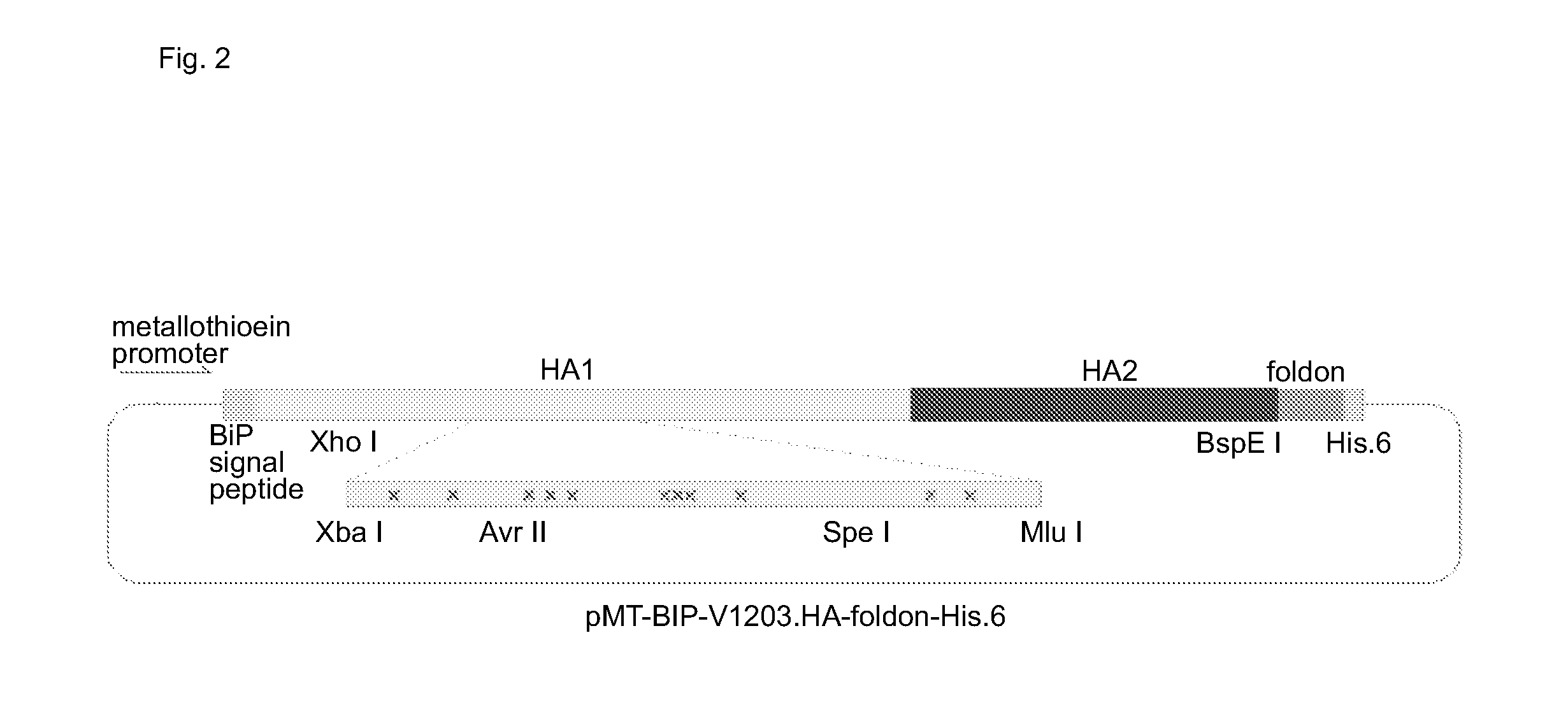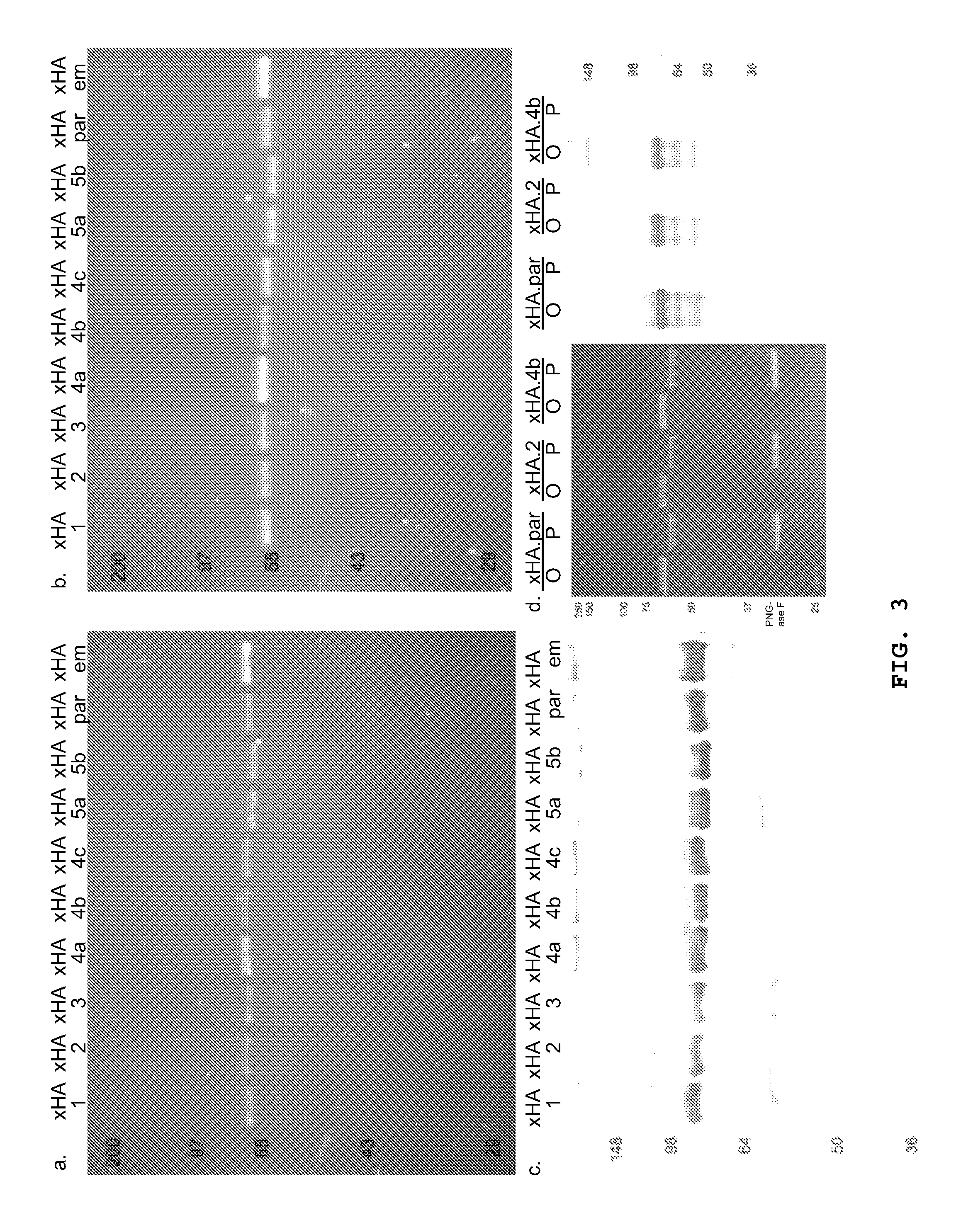Vaccine antigens that direct immunity to conserved epitopes
a technology of vaccine antigens and epitopes, applied in the field of vaccine antigens that direct immunity to conserved epitopes, can solve the problems of induction of immune response, poor effect of variant strains, and undesirable epitopes, and achieve the effect of strengthening the immune respons
- Summary
- Abstract
- Description
- Claims
- Application Information
AI Technical Summary
Benefits of technology
Problems solved by technology
Method used
Image
Examples
example 1
Hemagglutinin Expression and Purification
[0074]Recombinant influenza hemagglutinins produced by two different baculovirus-based insect cell expression strategies have been demonstrated to be suitable for vaccine trials (Treanor, J. J., et al., Dose-related safety and immunogenicity of a trivalent baculovirus-expressed influenza-virus hemagglutinin vaccine in elderly adults. J Infect Dis, 2006. 193(9): p. 1223-8.) and for high-resolution receptor binding and structural studies (Stevens, J., et al., Structure and receptor specificity of the hemagglutinin from an H5N1 influenza virus. Science, 2006. 312: p. 404-10., Stevens, J., et al., Structure of the uncleaved human H1 hemagglutinin from the extinct 1918 influenza virus. Science, 2004. 303: p. 1866-70.). Accordingly, baculovirus expression systems are appropriate for the expression of HA antigens.
[0075]The constructs of Stevens contain C-terminal foldon sequences to mediate correct folding of the HA, leading to crystallographically ...
example 2
Design and Production of xHA Mutants
[0085]V1203 primary antigenic determinants were ablated in x-HA variants by substitutions at epitope residues identified on the basis of escape mutant and genetic drift data. These positions were replaced with amino acids that are present at low frequencies on the antigen side of contact sites in a database of antigen-antibody crystal structures. Knockout of V 1203 specific primary antigenic determinants in xHA variants was verified by screening against a panel of well-characterized monoclonal antibodies (Kaverin et al., J Virol, 2007, 81:12911) obtained from the Biodefense and Emerging Infections Research (BEIR) repository.
[0086]Mapping of the Primary Antigenic Determinants
[0087]The first step in the design of the xHAs was to carefully analyze H5N1 antigenic drift and escape mutant data and to develop operational definitions of the primary antigenic determinants that will be knocked out. Table 2 presents the H5 A / Viet / 1203 / 04 HA1 ectodomain seque...
example 3
Production of Antisera to H5 Control and x-HA Hemagglutinins, Surrogate Assay for Viral Neutralization Function, and Identification of x-HA Universal Vaccine Candidates
[0101]Overview
[0102]The abilities of control and x-HA hemagglutinins to elicit broadly cross-protective humoral antibody responses were examined in mice. Antisera raised to individual control and x-HA hemagglutinins, as well as antisera raised by sequential challenge with different x-HAs, were screened in HA pseudotyped lentiviral vector reporter neutralization assays to identify molecules that stimulate responses to stable, conserved regions of H5 hemagglutinins.
[0103]Production of Mouse Antisera to Recombinant Hemagglutinins
[0104]Non-immune serum is collected from mice. Groups of 4 or 5 Balb / C or fVB mice are vaccinated by injection with 10 or 20 ug of a control or x-HA hemagglutinin in Sigma Adjuvant System (S6322, formerly Ribi Adjuvant System). Three weeks after the primary injection and at >21 day intervals afte...
PUM
| Property | Measurement | Unit |
|---|---|---|
| pH | aaaaa | aaaaa |
| size | aaaaa | aaaaa |
| pressure | aaaaa | aaaaa |
Abstract
Description
Claims
Application Information
 Login to View More
Login to View More - R&D
- Intellectual Property
- Life Sciences
- Materials
- Tech Scout
- Unparalleled Data Quality
- Higher Quality Content
- 60% Fewer Hallucinations
Browse by: Latest US Patents, China's latest patents, Technical Efficacy Thesaurus, Application Domain, Technology Topic, Popular Technical Reports.
© 2025 PatSnap. All rights reserved.Legal|Privacy policy|Modern Slavery Act Transparency Statement|Sitemap|About US| Contact US: help@patsnap.com



